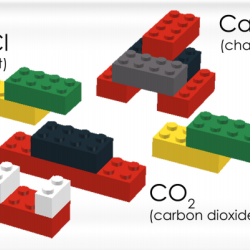Source Institutions
Source Institutions
Add to list Go to activity

This activity uses LEGO® bricks to represent atoms bonding into molecules and crystals. The lesson plan is for a 2.5 hour workshop (or four 45-minute classes). There is a "wet lab" chemistry experiment (mixing baking soda and calcium chloride with phenol red indicator), followed by a "LEGO lab" modeling phase that includes writing formulas using chemical notation. This lesson is also offered as a 2.5 hour field trip lesson at the MIT Edgerton Center.
- 10 to 30 minutes
- 2 to 4 hours
- Over $20 per group of students
- Ages 11 - adult
- Activity, Experiment/Lab Activity, Field Trip, Lesson/Lesson Plan, Model
- English
Quick Guide
Materials List (per group of students)
- Chemistry Student Pages
- Baking soda, 1 lb box
- Calcium chloride, a common de-icer found in grocery stores -- 9 lb container will be more than enough for 5 classes
- Phenolsulfonphthalein (phenol red) in aqueous solution (0.02% weight by volume, 500ml solution)
- Covered test tubes or vials, 10-15 ml capacity
- Resealable freezer bags 1-2 qt size, 3 bags per student pair -- the kind with a zipper may not hold the gas in very well
- Plastic spoons, 2 per student pair
- 50 ml beakers or similar container, 2 per 4 students
- Large tray, 1 for every pair
- Book of matches
- Pencils and erasers
- Splash goggles
- Chemical bin (optional)
- Gloves (optional)
- LEGO Atoms and Molecules Kit, 1 kit per student pair -- 24 white 1x2, 4 grey 2x4, 12 black 2x4, 8 yellow 2x4, 8 green 2x4, 36 red 2x4, 32 blue 2x4
- Laminated Sheets
- 6 petri dishes (or other small plates)
- 1 coffee filter
- 1 50 ml graduated cylinder
- 1 piece of thin cardboard
- 1 rubber band
Subjects
-
Physical Sciences
-
Heat and Thermodynamics
- Heat and Temperature
-
Chemistry
- Chemical Bonding
- Chemical Reactions
- Acids and Bases
-
States of Matter
- Solids
- Liquids
- Gases
- Changes of Phase
-
Structure and Properties of Matter
- Atomic Structure
- Elements and Periodic Table
-
Heat and Thermodynamics
-
The Nature of Science
-
The Scientific Process
- Asking Questions
- Conducting Investigations
- Gathering Data
- Formulating Explanations
- Communicating Results
-
The Scientific Process
Informal Categories
- Model Building
- Toys
Audience
To use this activity, learners need to:
- see
- see color
- read
- smell
- touch
Learning styles supported:
- Involves teamwork and communication skills
- Involves hands-on or lab activities
Other
Components that are part of this resource:
- Student pages - color
- Student pages - black and white
- Chemistry Answer Key
- Color laminated LEGO Layout Mat and Atom Key
- Baking Soda Calcium Chloride Mats
Includes alignment to state and/or national standards:
This resource is part of:
Access Rights:
- Free access
By:
- Vandiver, Ph.D., Kathleen M.
Rights:
- All rights reserved, MIT Edgerton Center, 2009
Funding Source:
- MIT Edgerton Center
